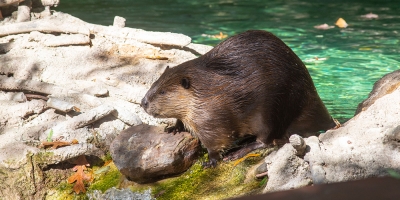
North American beavers have stocky bodies with a yellow-brown to almost black coat and a broad, flat, scaly tail. Their large, orange incisors grow continuously throughout their lifetime. They have webbed rear feet and digitated front paws. The beaver’s stocky body enables it to conserve heat.
A beaver’s long, dark-orange, visible incisors grow continuously throughout its life and are worn down through daily use. These teeth are self-sharpening and can cleave a willow the size of a person’s finger in a single bite! If the incisors become too long, they can prevent the beaver’s mouth from closing enough for its grinding molars to meet, which could lead to starvation.
Beavers regularly move between aquatic and terrestrial environments. Their small, dexterous front feet are well adapted to working on land. They walk on five digits, grasp sticks with their front paws and have well-developed digging claws. Their larger hind feet are webbed for swimming and void of fur, except on the dorsal surface.
The hind feet also have a preening toe, the second from the inside, with a unique double toenail. Beavers are meticulous groomers. They use the preening toe as a comb to prevent their fine, soft fur from matting to maintain its waterproofing and insulating properties. These flexible toes also remove burrs and parasites.
On land, a beaver’s movements are extremely awkward, making them vulnerable to predators. In water, however, beavers can swim up to 6 mph (10 kilometers per hour). Their oversized lungs allow them to stay submerged for up to 15 minutes while traveling over half a mile.
Whiskers help detect objects around a beaver’s face and head, which is especially helpful in narrow passageways and dark water. The beaver’s eyes have a thin, transparent membrane, called a nictitating membrane, which is pulled over the eyeball for underwater work. A beaver’s sight is good only for short distances and at close range. Its ears are external, small and rounded, with valves that also close while submerged, and the beaver’s auditory sense is well developed.
The shape of the tail is an individual and family trait, varying from short and broad to long and narrow. It is practically hairless and covered with black scales. There is a sharp demarcation between the fur and the scales, the fur remaining at full length and density right up to this line. The tail is used as a rudder in swimming, as a balance prop while working on land and to signal danger when slapped on the water. Beavers will also store fat in their tails, eating more in the fall so they can survive off the fat stored in their tails through winter if food is not available. The beaver’s vertebrae continue into and almost to the end of the tail.
Credit : Smithsonian National Zoo
Picture Credit : Google




